Abstract
MANY methods are now available for coupling enzymes and other biologically active compounds to solid supports1–4. Most involve the preliminary preparation of a special support or of a special derivative of a general support such as cellulose; for example, the carboxymethyl or p-amino-benzyl ether derivative. We have therefore sought coupling reagents which allow a more direct approach and have developed the use of cyanuric chloride and dichloro-s-triazines. The latter can be prepared as stable compounds with solubilizing groups such as carboxy–methoxy or carboxy–methylamino, which make them very convenient reagents.
Similar content being viewed by others
References
Grubhofer, N., and Scheith, L., Zeit. für Physiol. Chem. Hoppe Seyler's, 297, 108 (1954).
Micheel, F., and Ewers, J., Makromol. Chem., 3, 200 (1949).
Levin, Y., Pecht, M., Goldstein, L., and Katchalski, E., Biochemistry, 3, 1905 (1964).
Weetall, H. H., and Weliky, N., Nature, 204, 896 (1964).
Author information
Authors and Affiliations
Rights and permissions
About this article
Cite this article
KAY, G., CROOK, E. Coupling of Enzymes to Cellulose using Chloro-s-triazines. Nature 216, 514–515 (1967). https://doi.org/10.1038/216514a0
Received:
Published:
Issue Date:
DOI: https://doi.org/10.1038/216514a0
- Springer Nature Limited
This article is cited by
-
Direct conversion of starch hydrolysate to ethanol using a coimmobilizate of amyloglucosidase and saccharomyces cerevisiae in batch stirred tank reactor
Bioprocess Engineering (1992)
-
Matrix models
Histochemistry (1986)
-
Some possibilities for the immobilization of enzymes in poly(vinyl acetate-co-ethylene) tubes
Journal of Solid-Phase Biochemistry (1979)





